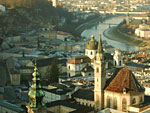Austria: Energy Market Profile
 Energy Overview
Energy OverviewAustria is heavily dependent on foreign energy sources. In 2007, imports less exports and domestic production totaled 78% percent of final energy consumption, up from 71% in 2005. This is primarily due to the demand for fossil fuel for transportation (petroleum products) and heating (natural gas), as well as imported electrical energy, which is cheaper than locally produced electricity.
According to 2007 figures, Austria covers 42% of its energy needs with liquid fossil fuels, 19% with imported electricity, 17% with natural gas, 14% with renewable energy sources, 5% via district heating (garbage incineration), and 2% coal. Of the energy Austria produces domestically, renewable sources are the most important, with a share of over 75.6%. This is due to two gifts of nature, namely, an alpine geography and rich
precipitation, which together make hydropower a highly feasible and readily available energy source. Well-maintained forests are another excellent source of renewable energy in various forms of biomass.
The market for renewable energy in Austria is driven to a large extent by political factors, including various legislative measures, international agreements and incentive programs designed to reward investment in cleaner, more efficient energy solutions. The single most important economic market driver over the past several years has been high and volatile fossil fuel prices.
Programs are in place to support the development of alternative energy generation such as wind and small hydro, however, the high costs associated with the electricity generated through alternative sources have effectively limited their true economic viability. Green energy is a typical “public domain” conflict: everyone is in favor of a clean and safe environment, but very few are willing to pay more for it.
Until now, little emphasis has been placed on encouraging people to reduce their electricity use both through technology and awareness. This is changing as programs that inform the public about energy saving strategies and products are put into place.
Though the legal framework surrounding the deregulation and unbundling of the Austrian electricity market has been described as excellent, the former monopolists have been able to de facto maintain their hold on the largest part of the electricity market. A recent study released by the Austrian Federal Competition Authority (Bundeswettbewerbsbehoerde) came to the conclusion that there are several factors involved in the continued dominance of the former monopolists in the electricity market, of which the most important are: price schemes that are not transparent for consumers; worries among end-users that their service could be interrupted or become less reliable; and a general lack of marketing by new energy providers. Measures are currently being undertaken to improve the situation and make it even easier for end-users to switch providers.
Power Generation and Transmission
Austrian electric power generation and distribution systems are among the most reliable and environmentally friendly in Europe. Though dependence on foreign electricity is a matter of concern for policy makers, the relatively high cost associated with local power generation (in accordance with environmental concerns and regulations) has brought a continuous shift to foreign-sourced electricity.
The market for electric power is characterized by increasing consumption, stable production levels, and increasing imports. In 2007, total electricity consumption rose to 70,903 GWh, up slightly from 70,778 in 2006. At the same time, production has ranged between a low of 34,000 GWh (2006) and 36,000 GWh (2004), reaching 34,900 GWh in 2007.
The most important source of Austrian electric energy is water: there are 627 run-of-river plants, 101 pumped storage plants, and 1,777 non-allocated hydro power plants located in Austria. Together, these facilities account for around 60% of locally produced electricity. The second most important source of electricity is fossil-fueled power plants: there are 615 thermal plants currently on line, generating around 36% of the local production volume. Most of the thermal plants are either gas fired, though a respectable minority (around 15%) is run on biogenic fuels. The remaining 4% are a mix of wind, solar, and other alternative energy sources. There is no nuclear power generation in Austria.
The Austrian electricity market is dominated by a handful of major players, all former regional monopolists. The largest three providers account for over 65% of the end-user market, and the largest 5 hold over 80%. The situation is complicated by the fact that these companies have bought interest in or formed alliances with each other, making it difficult to correctly identify exact market shares. According to E-Control, the largest electricity end-user suppliers are EnergieAlliance with 32.9%, EnergieAG with 15.5%, and Steweag-Steg with 14%. Other significant players are Salzburg AG with 6.1%, KELAG with 6%, and APC with 5.2%.
The most interesting business opportunities for U.S. companies in Austria at this time are in pumped storage facilities, combined cycle facilities, alternative energy projects, and the completion of the high voltage network. Investments upwards of 7 billion Euro ($11 billion) are planned for the time period between 2008 and 2015, both in Austria and in joint-venture operations run by Austrian companies such as Verbund. Favored alternative energy projects include wind, biomass and solar. The last 171 kilometers of the 380 kV high-voltage circuit (total length: 1,800 km) is scheduled to be completed in 2010.
Excerpts from: Austria: Energy Market Profile, May 2009
You can return to the main Market News page, or press the Back button on your browser.

